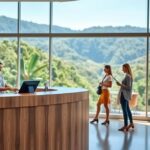Costa Rica Immigration Trends to Watch in 2025

Over the years, Costa Rica has emerged as a top destination for individuals and families seeking a new place to call home. Known for its stunning landscapes, pleasant climate, and vibrant culture, this country offers a unique blend of opportunities for those looking to relocate.
The welcoming environment and high quality of life have drawn a diverse range of migrants. From retirees to young professionals, many are drawn to the promise of a peaceful and fulfilling lifestyle. This growing interest is reflected in recent statistics, which show a steady increase in daily entries and government responses to manage this influx.
As we explore the evolving landscape, we’ll delve into the factors driving these changes and what they mean for the future. Stay tuned as we uncover the trends, policies, and humanitarian efforts shaping this dynamic scenario.
Overview of Costa Rica immigration trends in 2025
Recent data highlights a dramatic rise in daily entries, reshaping the migration scenario. This surge is driven by a combination of factors, including shifting routes and evolving policies. Understanding these changes is crucial for predicting future trends.
Key Statistics and Projections
According to the IOM’s Displacement Tracking Matrix, migrant arrivals increased by 130% between January and May 2024. This exponential growth is expected to continue into 2025. Historical patterns suggest that October often marks a peak in migration activity, further influencing projections.
Health guidelines have also played a significant role in shaping these flows. National and international policies have adapted to ensure safety while managing the influx. These measures are critical for maintaining stability and addressing the needs of migrants.
Emerging Patterns and Daily Entries
Migration routes have shifted significantly over the past year. New pathways have emerged, particularly in response to policy changes and state of emergency measures. These shifts are being closely monitored by agencies like the IOM and local governments.
Daily entries provide valuable insights into these trends. By analyzing this data, we can better understand the broader impacts of migration. For those considering relocation, exploring residency options is an essential step in navigating this evolving landscape.
Residency Options and Lifestyle Benefits in Costa Rica
For those seeking a balanced lifestyle, residency programs in this Central American nation offer a gateway to a fulfilling life. With options like rentista, investment, and permanent residency, individuals and families can find solutions tailored to their unique needs. These programs are part of a well-structured system designed to integrate newcomers into the local community seamlessly.
Exploring Rentista, Investment, and Permanent Residency
The rentista program is ideal for those with a steady income, requiring a minimum monthly transfer or a fixed deposit. For investors, the program offers a pathway to residency with a lower investment threshold, making it accessible to many. Permanent residency, on the other hand, is available after three years of temporary residency, providing long-term stability.
Each option is designed to cater to different lifestyles. Whether you’re a retiree, entrepreneur, or family, the national system ensures a smooth transition. Access to reliable information and organized operations makes the process straightforward, even in emergency situations.
Quality of Life and Cultural Integration
Residency here is more than a legal status—it’s an opportunity to embrace a vibrant culture and stunning natural beauty. The mild climate, affordable cost of living, and top-tier healthcare system enhance the quality of life for residents. Cultural integration is encouraged through community events and local initiatives, fostering a sense of belonging.
From the lush rainforests to the bustling cities, this country offers a unique blend of tranquility and adventure. Whether you’re reading about local traditions or exploring the outdoors, the experience is enriching. Residency programs here are not just about settling down; they’re about thriving in a welcoming and dynamic environment.
Humanitarian and Community Impact of Migration
The humanitarian impact of migration has become a critical focus for organizations and governments alike. As daily entries continue to rise, the need for coordinated responses has never been more urgent. This section explores the efforts to address these challenges and the gaps that remain.
IOM and Government Coordination Efforts
The International Organization for Migration (IOM) has been at the forefront of crisis response operations. Working closely with the Costa Rican government, they’ve implemented strategies to support vulnerable migrants. For example, the Displacement Tracking Matrix (DTM) collects vital data to identify needs and improve resource allocation.
Despite these efforts, funding gaps remain a significant hurdle. Only 15% of the Regional Migrant Response Plan for Venezuela is currently funded. This shortfall affects essential services like food, water, and shelter, leaving many migrants in precarious conditions.
Local Community Responses and Service Gaps
Local communities have also felt the strain of increased migration. Protests and social tensions have emerged as resources are stretched thin. For instance, 44% of migrants report needing food assistance, while 18% lack access to clean water. These gaps highlight the urgent need for a united approach.
Organizations like the Panamanian Red Cross have stepped up, providing water filtration and hygiene kits. However, the demand far exceeds the available resources. Addressing these challenges requires a strategy that links humanitarian assistance with community development.
For those navigating this complex landscape, understanding the role of legal services in Costa Rica is essential. These services ensure that migrants can access their rights and integrate smoothly into society.
Economic and Policy Implications for Future Trends
Economic and policy shifts are reshaping migration dynamics in Central America. These changes are driven by international decisions and regional strategies, influencing the number of migrants and their routes. Understanding these factors is key to predicting future patterns.
Influence of U.S. Elections and Regional Policies
U.S. election cycles often serve as key decision points for migration trends. Changes in U.S. policies can lead to shifts in the number of migrants entering neighboring countries. For example, stricter border controls may redirect flows through alternative routes, including Nicaragua.
Regional policies also play a significant role. Coordinated operations with Panama have helped manage migrant transfers more effectively. These efforts highlight the importance of international collaboration in addressing migration challenges.
Sustainable Investments and Strategic Opportunities
Sustainable investments are creating new opportunities for both the country and migrants. Initiatives like decarbonization projects and renewable energy programs are attracting international attention. These efforts not only boost the economy but also provide employment opportunities for newcomers.
Strategic economic applications are essential for long-term stability. By focusing on data-driven policies, governments can better manage the exchange of resources and services. This approach ensures that the majority of migrants benefit from these initiatives.
For those considering relocation, exploring naturalization benefits can provide valuable insights into long-term residency options.
Conclusion
As we conclude our analysis, it’s clear that monitoring these developments is crucial for shaping the future. Addressing challenges and gaps requires a continued global and national initiative. The role of international actors, including those from Venezuela and other regions, is vital in supporting migration management.
Providing priority to the well-being of both individuals and communities is essential for sustained progress. Accurate datum and well-informed analysis are key to supporting policy decisions and economic strategies. Our discussion today is only the beginning, and we remain committed to following these developments across America and the world.
We invite readers to join us as we continue to monitor and analyze emerging trends. Ensuring that every initiative and policy change is examined from both a general and individual perspective will help create a more inclusive and sustainable future.
Article by Jonnathan Morales
Start Today!
Call or WhatsApp (+506) 7182-8969
https://www.jaroscr.com/


